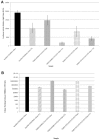Biological and Mechanical Evaluation of Novel Prototype Dental Composites
- PMID: 30189149
- PMCID: PMC6304716
- DOI: 10.1177/0022034518795673
Biological and Mechanical Evaluation of Novel Prototype Dental Composites
Abstract
The breakdown of the polymeric component of contemporary composite dental restorative materials compromises their longevity, while leachable compounds from these materials have cellular consequences. Thus, a new generation of composite materials needed to be designed to have a longer service life and ensure that any leachable compounds are not harmful to appropriate cell lines. To accomplish this, we have developed concurrent thiol-ene-based polymerization and allyl sulfide-based addition-fragmentation chain transfer chemistries to afford cross-linked polymeric resins that demonstrate low shrinkage and low shrinkage stress. In the past, the filler used in dental composites mainly consisted of glass, which is biologically inert. In several of our prototype composites, we introduced fluorapatite (FA) crystals, which resemble enamel crystals and are bioactive. These novel prototype composites were benchmarked against similarly filled methacrylate-based bisphenol A diglycidyl ether dimethacrylate / triethylene glycol dimethacrylate (bisGMA/TEGDMA) composite for their cytotoxicity, mechanical properties, biofilm formation, and fluoride release. The leachables at pH 7 from all the composites were nontoxic to dental pulp stem cells. There was a trend toward an increase in total toughness of the glass-only-filled prototype composites as compared with the similarly filled bisGMA/TEGDMA composite. Other mechanical properties of the glass-only-filled prototype composites were comparable to the similarly filled bisGMA/TEGDMA composite. Incorporation of the FA reduced the mechanical properties of the prototype and bisGMA/TEGDMA composite. Biofilm mass and colony-forming units per milliliter were reduced on the glass-only-filled prototype composites as compared with the glass-only-filled bisGMA/TEGDMA composite and were significantly reduced by the addition of FA to all composites. Fluoride release at pH 7 was greatest after 24 h for the bisGMA/TEGDMA glass + FA composite as compared with the similarly filled prototypes, but overall the F- release was marginal and not at a concentration to affect bacterial metabolism.
Keywords: apatites; biocompatibility; biofilm(s); composite materials; fluoride(s); resin(s).
Conflict of interest statement
The authors declare no other potential conflicts of interest with respect to the authorship and/or publication of this article.
Figures




Similar articles
-
Alternative monomer for BisGMA-free resin composites formulations.Dent Mater. 2020 Jul;36(7):884-892. doi: 10.1016/j.dental.2020.04.009. Epub 2020 May 8. Dent Mater. 2020. PMID: 32402514 Free PMC article.
-
Evaluation of highly reactive mono-methacrylates as reactive diluents for BisGMA-based dental composites.Dent Mater. 2009 Jan;25(1):33-8. doi: 10.1016/j.dental.2008.05.003. Epub 2008 Jun 27. Dent Mater. 2009. PMID: 18584862 Free PMC article.
-
Ester-free thiol-ene dental restoratives--Part A: Resin development.Dent Mater. 2015 Nov;31(11):1255-62. doi: 10.1016/j.dental.2015.08.148. Epub 2015 Sep 7. Dent Mater. 2015. PMID: 26360013 Free PMC article.
-
New Resins for Dental Composites.J Dent Res. 2017 Sep;96(10):1085-1091. doi: 10.1177/0022034517720658. Epub 2017 Jul 21. J Dent Res. 2017. PMID: 28732183 Free PMC article. Review.
-
Dental restorative composite materials: A review.J Oral Biosci. 2019 Jun;61(2):78-83. doi: 10.1016/j.job.2019.04.001. Epub 2019 May 15. J Oral Biosci. 2019. PMID: 31109861 Review.
Cited by
-
Bioenergetic Impairment of Triethylene Glycol Dimethacrylate- (TEGDMA-) Treated Dental Pulp Stem Cells (DPSCs) and Isolated Brain Mitochondria are Amended by Redox Compound Methylene Blue †.Materials (Basel). 2020 Aug 6;13(16):3472. doi: 10.3390/ma13163472. Materials (Basel). 2020. PMID: 32781723 Free PMC article.
-
The Photoinitiators Used in Resin Based Dental Composite-A Review and Future Perspectives.Polymers (Basel). 2021 Feb 2;13(3):470. doi: 10.3390/polym13030470. Polymers (Basel). 2021. PMID: 33540697 Free PMC article. Review.
-
Study on the mechanical and aging properties of an antibacterial composite resin loaded with fluoride-doped nano-zirconia fillers.Front Bioeng Biotechnol. 2024 May 23;12:1397459. doi: 10.3389/fbioe.2024.1397459. eCollection 2024. Front Bioeng Biotechnol. 2024. PMID: 38846803 Free PMC article.
-
Application Study of Novel Eggshell/Ag Combined with Pit and Fissure Sealants.Int J Nanomedicine. 2023 Jun 1;18:2911-2922. doi: 10.2147/IJN.S403974. eCollection 2023. Int J Nanomedicine. 2023. PMID: 37283713 Free PMC article.
-
Developments in resin-based composites.Br Dent J. 2022 May;232(9):638-643. doi: 10.1038/s41415-022-4240-8. Epub 2022 May 13. Br Dent J. 2022. PMID: 35562465 Free PMC article. Review.
References
-
- Carioscia JA, Lu H, Stanbury JW, Bowman CN. 2005. Thiol-ene oligomers as dental restorative materials. Dent Mater. 21(12):1137–1143. - PubMed
-
- Carioscia JA, Schneidewind L, O’Brien C, Ely R, Feeser C, Cramer N, Bowman CN. 2007. Thiol-norbornene materials: approaches to develop high tg thiol-ene polymers. J Polym Sci A Polym Chem. 45(23):5686–5696.
Publication types
MeSH terms
Substances
Grants and funding
LinkOut - more resources
Full Text Sources
Other Literature Sources
Miscellaneous

